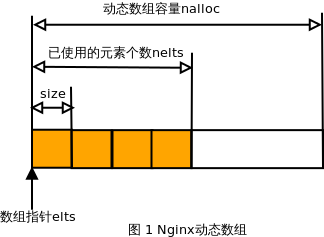数组是C语言中最常用的数据类型之一,按固定大小分割。但是C语言中的数组是不能动态扩展,所以Nginx做了一个封装,成为类似于C++ STL中vector的数据类型。 优点:
- 访问速度快
- 元素个数可以动态扩展
- 内存池统一管理内存
文件在src/core/ngx_array.h和src/core/ngx_array.c两个文件中。
// 比如cookies是以ngx_array_t数组存储的
// struct ngx_array_t
// nginx 数组结构 {{{
typedef struct {
void *elts; // 数组起始位置,可以是ngx_keyval_t ngx_str_t ngx_bufs_t ngx_hash_key_t等
ngx_uint_t nelts; // 数组元素个数
size_t size; // 单个元素大小
ngx_uint_t nalloc; // 空间能够容纳元素个数
ngx_pool_t *pool; // 内存池,赋值见ngx_init_cycle,为cycle的时候分配的pool空间
} ngx_array_t; // }}}// 动态数组创建
ngx_array_t *ngx_array_create(ngx_pool_t *p, ngx_uint_t n, size_t size);
// 动态数组销毁
void ngx_array_destroy(ngx_array_t *a);
// 在动态数组尾部插入一个元素
void *ngx_array_push(ngx_array_t *a);
// 在动态数组尾部插入n个元素
void *ngx_array_push_n(ngx_array_t *a, ngx_uint_t n);首先分配数组头,然后分配数组数据区,两次分配均在传入的内存池(pool指向内存池)中进行,然后简单初始化数组头并返回数组头起始位置。
ngx_array_t *
ngx_array_create(ngx_pool_t *p, ngx_uint_t n, size_t size)
{
ngx_array_t *a;
// 分配动态数组头部
a = ngx_palloc(p, sizeof(ngx_array_t));
if (a == NULL) {
return NULL;
}
// 分配容量为n的动态数组数据区,并将其初始化
if (ngx_array_init(a, p, n, size) != NGX_OK) {
return NULL;
}
return a;
}
// 数组结构初始化(ngx_array_create 中调用)
static ngx_inline ngx_int_t
ngx_array_init(ngx_array_t *array, ngx_pool_t *pool, ngx_uint_t n, size_t size)
{
/*
* set "array->nelts" before "array->elts", otherwise MSVC thinks
* that "array->nelts" may be used without having been initialized
*/
array->nelts = 0;
array->size = size;
array->nalloc = n;
array->pool = pool;
// 为数组分配初始空间
array->elts = ngx_palloc(pool, n * size);
if (array->elts == NULL) {
return NGX_ERROR;
}
return NGX_OK;
}销毁数组的操作实现如下,包括销毁数组数据区和数组头。销毁动作实际上就是修改内存池的 last 指针,即数组的内存被内存池回收,并没有调用 free 等释放内存的操作。
void
ngx_array_destroy(ngx_array_t *a)
{
ngx_pool_t *p;
p = a->pool;
// 移动内存池的last指针,释放数组所有元素所占据的内存
if ((u_char *) a->elts + a->size * a->nalloc == p->d.last) {
p->d.last -= a->size * a->nalloc;
}
// 释放数组首指针所占据的内存
if ((u_char *) a + sizeof(ngx_array_t) == p->d.last) {
p->d.last = (u_char *) a;
}
}数组添加元素的操作有两个,ngx_array_push 和ngx_array_push_n,分别添加一个和多个元素。
实际的添加操作并不在这两个函数中完成,只是在这两个函数中申请元素所需的内存空间,并返回指向该内存空间的首地址,在利用指针赋值的形式添加元素。
void *
ngx_array_push(ngx_array_t *a)
{
void *elt, *new;
size_t size;
ngx_pool_t *p;
// 判断数组是否已满
if (a->nelts == a->nalloc) {
// 计算数组所有元素占据的内存大小
size = a->size * a->nalloc;
p = a->pool;
/* 若当前内存池的内存空间至少可容纳一个元素大小 */
if ((u_char *) a->elts + size == p->d.last
&& p->d.last + a->size <= p->d.end)
{
/*
* the array allocation is the last in the pool
* and there is space for new allocation
*/
p->d.last += a->size;
a->nalloc++;
} else {
/* allocate a new array */
/* 新的数组内存为当前数组大小的 2 倍 */
new = ngx_palloc(p, 2 * size);
if (new == NULL) {
return NULL;
}
/* 首先把现有数组的所有元素复制到新的数组中 */
ngx_memcpy(new, a->elts, size);
a->elts = new;
a->nalloc *= 2;
}
}
elt = (u_char *) a->elts + a->size * a->nelts;
a->nelts++;
return elt;
}
// 数组增加n个元素
void *
ngx_array_push_n(ngx_array_t *a, ngx_uint_t n)
{
void *elt, *new;
size_t size;
ngx_uint_t nalloc;
ngx_pool_t *p;
size = n * a->size;
if (a->nelts + n > a->nalloc) {
/* the array is full */
p = a->pool;
if ((u_char *) a->elts + a->size * a->nalloc == p->d.last
&& p->d.last + size <= p->d.end)
{
/*
* the array allocation is the last in the pool
* and there is space for new allocation
*/
p->d.last += size;
a->nalloc += n;
} else {
/* allocate a new array */
nalloc = 2 * ((n >= a->nalloc) ? n : a->nalloc);
new = ngx_palloc(p, nalloc * a->size);
if (new == NULL) {
return NULL;
}
ngx_memcpy(new, a->elts, a->nelts * a->size);
a->elts = new;
a->nalloc = nalloc;
}
}
elt = (u_char *) a->elts + a->size * a->nelts;
a->nelts += n;
return elt;
}